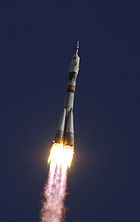Soyuz-2-1v
 Launch of an Soyuz-2.1v carrying Kosmos 2525 military satellite on 28 March 2018. | |
| Function | Lightcarrier rocket |
|---|---|
| Manufacturer | TsSKB Progress |
| Country of origin | Russia |
| Size | |
| Height | 44 m (144 ft) |
| Diameter | 3 m (9.8 ft) |
| Mass | 158,000 kg (348,000 lb) |
| Stages | 2 |
| Capacity | |
| Payload to 200 km x 51.8°LEO | |
| Mass | 2,850 kg (6,280 lb) |
| Payload to 200 km x 62.8°LEO | |
| Mass | 2,800 kg (6,200 lb) |
| Associated rockets | |
| Family | R-7/Soyuz-2 |
| Comparable | Long March 2C PSLV |
| Launch history | |
| Status | Active |
| Launch sites | Plesetsk,Site 43 |
| Total launches | 12 |
| Success(es) | 11 |
| Failure(s) | 0 |
| Partial failure(s) | 1 |
| First flight | 28 December 2013 |
| Last flight | 9 February 2024 |
TheSoyuz-2.1v(Russian:Союз 2.1в,Union 2.1v),GRAU index14A15,[1]known earlier in development as theSoyuz-1(Russian:Союз 1,Union 1), is a Russianexpendablelaunch vehicle.It is a heavily modified derivative of theSoyuz-2.1b,and is a member of theR-7 familyof rockets. It is built byTsSKB Progress,atSamarain Russia. Launches are conducted from existing facilities at thePlesetsk Cosmodromein Northwest Russia, with pads also available at theBaikonur CosmodromeinKazakhstan,[2]and new facilities at theVostochny Cosmodromein Eastern Russia.[3]
Vehicle[edit]

The Soyuz-2.1v represents a major departure from earlierSoyuzrockets. Unlike the Soyuz-2.1b upon which it is based, it does away with the four boosters used on all otherR-7vehicles. The first stage of the Soyuz-2.1v is based on the Soyuz-2 second stage, with a single-chamberNK-33engine replacing the four-chamberRD-108along with structural modifications. Since the NK-33 is fixed, the stage is also equipped with fourRD-0110Rengines for thrust vector control. The RD-0110R engines add 230.5 kN (51,800 lbf) thrust and heats the pressurization gases.[4]
The NK-33 engines were built in the 1970s for the cancelled SovietN1Moon rocket. These surplus engines offer increased performance over the RD-107; however, only a limited number of engines are available. Once the supply is exhausted, the NK-33 will be replaced by theRD-193.In April 2013, it was announced that the RD-193 engine had completed testing. The RD-193 is a lighter and shorter engine based on theAngara'sRD-191,which is itself a derivative of theZenit'sRD-170.[5]
The second stage of the Soyuz-2.1v is the same as the third stage of the Soyuz-2.1b;[6]powered by anRD-0124engine. Most missions will use aVolgaupper stage to transfer the payload from an initial parking orbit to its final destination. The Volga is derived from the propulsion system of theYantarreconnaissance satellite,and was developed as a lighter and cheaper alternative to theFregat.
The Soyuz-2.1v was designed as a light-class carrier rocket, and has a payload capacity of 2,850 kg (6,280 lb) to a 200 km (120 mi) circularlow Earth orbitwith aninclinationof 51.8° from Baikonur, and 2,800 kg (6,200 lb) to a 200 kilometre orbit at 62.8° from Plesetsk.[2][7]
List of launches[edit]
| Flight number | Date (UTC) | Launch site | Upper stage | Payload | Orbit | Remarks | Outcome |
|---|---|---|---|---|---|---|---|
| 1 | 28 December 2013 13:30 |
PlesetskSite 43/4 | Volga | Aist 1,SKRL-756 #1/2 | LEO | Maiden flight of Soyuz-2.1v | Success |
| 2 | 5 December 2015 15:08 |
PlesetskSite 43/4 | Volga | Kosmos 2511 and 2512 | LEO | Earth observationRadar calibration | Partial failure |
| 3 | 23 June 2017 18:04 |
PlesetskSite 43/4 | Volga | Kosmos 2519 | LEO | Military satellite, possiblygeodesyprojectNivelir-ZU | Success |
| 4 | 29 March 2018 17:38 |
PlesetskSite 43/4 | None | Kosmos 2525(EMKA) | SSO | Military Satellite | Success |
| 5 | 10 July 2019 17:14 |
PlesetskSite 43/4 | Volga | Kosmos 2535 to 2538 | LEO | Geodesy | Success |
| 6 | 25 November 2019 17:52 |
PlesetskSite 43/4 | Volga | Kosmos 2542 & 2543 | LEO | Satellite inspection | Success |
| 7 | 9 September 2021 19:59 |
PlesetskSite 43/4 | Volga | Kosmos 2551(EMKA No.2) | SSO | Reconnaissance | Success |
| 8 | 1 August 2022 20:25 |
PlesetskSite 43/4 | Volga | Kosmos 2558(Nivelir No.3) | PO | Surveillance | Success |
| 9 | 21 October 2022 19:20 |
PlesetskSite 43/4 | Volga | Kosmos 2561 & 2562[8] | SSO | Surveillance | Success |
| 10 | 29 March 2023 19:57 |
PlesetskSite 43/4 | None | Kosmos 2568(EO MKA #4) | SSO | Reconnaissance | Success |
| 11 | 27 December 2023 07:03 |
PlesetskSite 43/4 | None | Kosmos 2574(Razbeg No.1) | SSO | Reconnaissance | Success |
| 12 | 9 February 2024 07:03 |
PlesetskSite 43/4 | None | Kosmos 2575(Razbeg No. 2) | SSO | Reconnaissance | Success |
Photogallery from Paris Air Show 2011[edit]
-
General view of the rocket
-
Second stage view
-
Detailed view of the payload section
Russia exhibited a model of the Soyuz-2.1v during the2011 Paris Air ShowatLe Bourget.
See also[edit]
References[edit]
- ^"Rus/Souyz-2 launch vehicle"(in Russian). Plesetsk Cosmodrome.Retrieved30 December2013.
- ^ab""Soyuz-1" middle class launch vehicle ".Samara Space Centre. Archived fromthe originalon 19 April 2009.Retrieved11 April2009.
- ^Peslyak, Alexander (24 July 2013)."Vostochny Cosmodrome clears the way to deep space".rbth.co.uk.Russia Beyond The Headlines.Retrieved30 December2013.
- ^"Steering engine RD0110R (14D24) Carrier rocket" Soyuz-2.1v ""(in Russian). KBKhA.Retrieved1 June2015.
- ^"New engine for light rocket" Soyuz "prepare for mass production at the end of the year"(in Russian). Новости космонавтики.Retrieved8 April2013.
- ^Zak, Anatoly."Origin of the Soyuz-1 project".RussianSpaceWeb.Retrieved30 December2013.
- ^"Soyuz -2.1 B".10 November 2014.
- ^"Ракета «Союз-2.1в» с секретными военными спутниками стартовала с космодрома Плесецк".21 October 2022.




